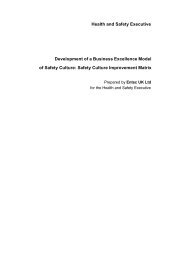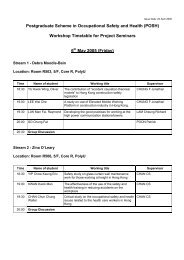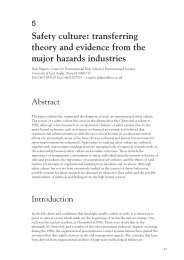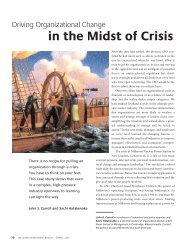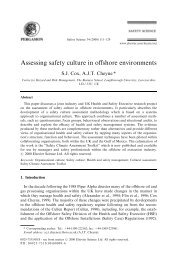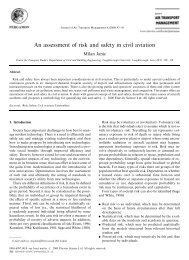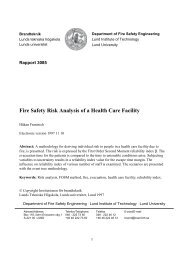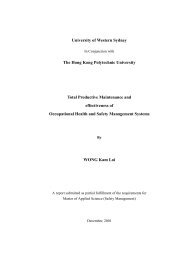The relationship between employees' perceptions of safety and ...
The relationship between employees' perceptions of safety and ...
The relationship between employees' perceptions of safety and ...
Create successful ePaper yourself
Turn your PDF publications into a flip-book with our unique Google optimized e-Paper software.
M. O’Toole / Journal <strong>of</strong> Safety Research 33 (2002) 231–243 237<br />
circumstances, a response rate <strong>of</strong> 20%–30% would normally be expected. Although the<br />
response rate was lower than expected, there appears to be no systematic bias introduced,<br />
as the distribution phenomenon appeared to be somewhat r<strong>and</strong>om <strong>and</strong> uniform throughout<br />
the company. Most <strong>of</strong> the locations had a response rate that reflected the overall average<br />
response rate, with no locations below a 26% response rate or above a 50% response rate.<br />
Table 1 shows the percent response by company geographical groupings.<br />
6. Results<br />
To analyze the <strong>safety</strong> survey responses, the totals for each question were compared <strong>and</strong><br />
the percent <strong>of</strong> ‘‘positive’’ responses was computed. This was accomplished by simply<br />
adding the number <strong>of</strong> ‘‘yes’’ responses for each question <strong>and</strong> dividing by the total<br />
responses for that question. For example, Question 1 had a total <strong>of</strong> 1375 responses, <strong>of</strong><br />
which 1232 were positive (yes), to equal a 90.8% positive response rate for this question.<br />
Each <strong>of</strong> the questions on the survey has a positive answer, which indicates the existence <strong>of</strong><br />
some aspect <strong>of</strong> a good <strong>safety</strong> system. <strong>The</strong> positive answer on most, but not all questions, is<br />
‘‘yes.’’ <strong>The</strong> questions reflect different aspects <strong>of</strong> the management system.<br />
Extensive data sets are used to show these questions are ‘‘valid’’ measures <strong>of</strong> the <strong>safety</strong><br />
system. This means that sites or organizations with higher injury rates will have fewer<br />
positive scores on the survey questions.<br />
In order to better underst<strong>and</strong> the meaning <strong>of</strong> the results from this survey, a series <strong>of</strong><br />
factor analyses had been previously conducted on the data from the normative data set. A<br />
factor analysis is a statistical analysis designed to discover groups <strong>of</strong> questions that<br />
correlate with each other. <strong>The</strong> statistical analysis is combined with an analysis <strong>of</strong> question<br />
content to arrive at a set <strong>of</strong> factors. This survey was determined to measure seven factors.<br />
<strong>The</strong> factor analysis was conducted on two samples. <strong>The</strong> first was 6306 surveys received<br />
from one company in 1994. <strong>The</strong> second was a smaller number <strong>of</strong> cases from another<br />
company in the same year. <strong>The</strong> model was developed on the larger data set <strong>and</strong> then was<br />
tested on the smaller data set.<br />
<strong>The</strong> variance explained by the factors is shown in Table 2.<br />
Many questions load on more than one factor, but for simplicity, each question was<br />
allowed to represent the factor with the highest loading. Factor loadings for questions<br />
Table 2<br />
Percent variance explained<br />
Factor Name Percent <strong>of</strong> variance explained<br />
1 Management’s Commitment to Safety 11.94<br />
2 Education <strong>and</strong> Knowledge 5.62<br />
3 Safety Supervisory Process 9.72<br />
4 Employee Involvement <strong>and</strong> Commitment 5.48<br />
5 Drugs <strong>and</strong> Alcohol 3.04<br />
6 Emergency Response 7.59<br />
7 Off-the-Job Safety 3.89<br />
Total 47.26




